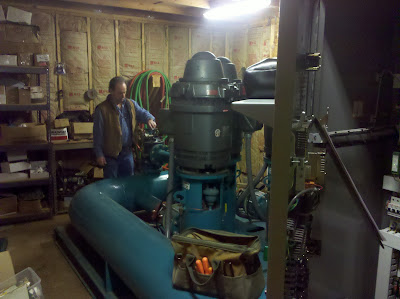We ended last week on a nice note with some very nice weather. We managed to cut the fairways, topdress the greens and mow them twice! We even managed to get some rough cut. What a difference a few nice days can make. The forecast for this weeks weather shows we are in for some clear and dry days but we are also more than likely going to be in a frost situation. Morning temperatures will be in the mid 20's but the afternoons will be warming to the mid 40's.
The maintenance staff will be busy chipping brush and clearing invasive plants from the wetlands and pond buffers until the frost has melted. We are still cutting the greens once a week, mowing on Thursdays or Fridays. With the frosty weather pattern we will most likely be mowing the greens in the late afternoon to avoid holding up play in the morning. The greens are due of a shot of fertilize this week and we may have to spray in the afternoon as well.
Steve has had a busy week in the shop. He has been preparing our large Dakota 440 for the topdressing season. Wear and tear over the years has forced us to replace the spinners and the spinner shafts as well as the seal kit on one of the main hydraulic motors. The repairs are pretty expensive but extremely necessary for us to continue it's operation.
 Our walking greens mowers have not been giving us the quality of cut that we demand from them. Lately we have notice some minor scalping from the edges of the bedknife. We depend on these machines mostly in the winter when the greens are soft so we can prevent scalping. They are now causing the problem. Steve has determined that the rear drums are the main culprit. Using his calipers he can see the difference across the drum in thousandths of inches. Any difference within 5 thousandths can be very noticeable. Two of the three will need new reels while all three are in need of new rear drums and shafts. To replace just the two rear sections of the drum including bearings and shafts we are looking at $1,100 each, not what we were expecting. For now we will limp them along to the best we can until we can determine a proper course of action.
Our walking greens mowers have not been giving us the quality of cut that we demand from them. Lately we have notice some minor scalping from the edges of the bedknife. We depend on these machines mostly in the winter when the greens are soft so we can prevent scalping. They are now causing the problem. Steve has determined that the rear drums are the main culprit. Using his calipers he can see the difference across the drum in thousandths of inches. Any difference within 5 thousandths can be very noticeable. Two of the three will need new reels while all three are in need of new rear drums and shafts. To replace just the two rear sections of the drum including bearings and shafts we are looking at $1,100 each, not what we were expecting. For now we will limp them along to the best we can until we can determine a proper course of action.As our equipment ages, repairs are going to become a larger part of our maintenance budget until we can replace the equipment that has outlived it's usefulness. I am certainly grateful we have Steve as our equipment manger. He is one of the best I have seen!





















